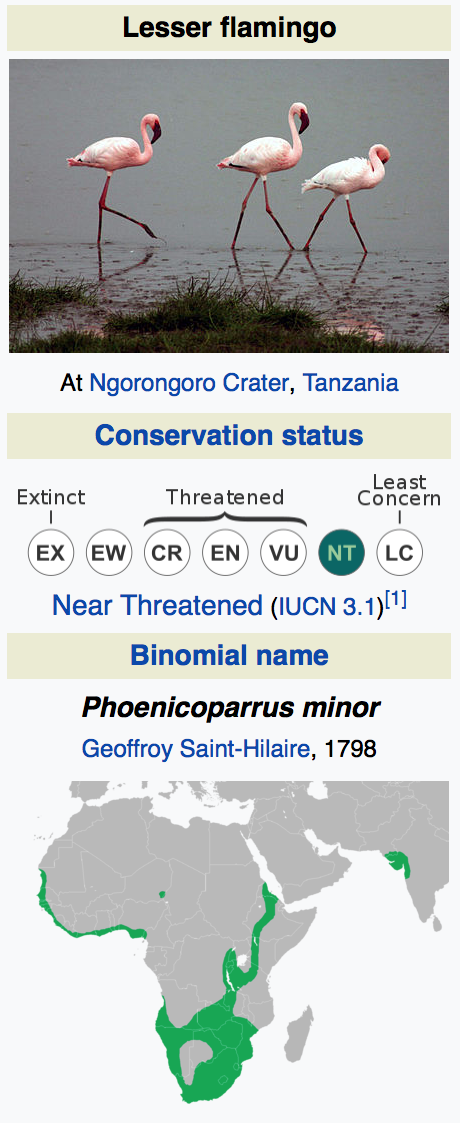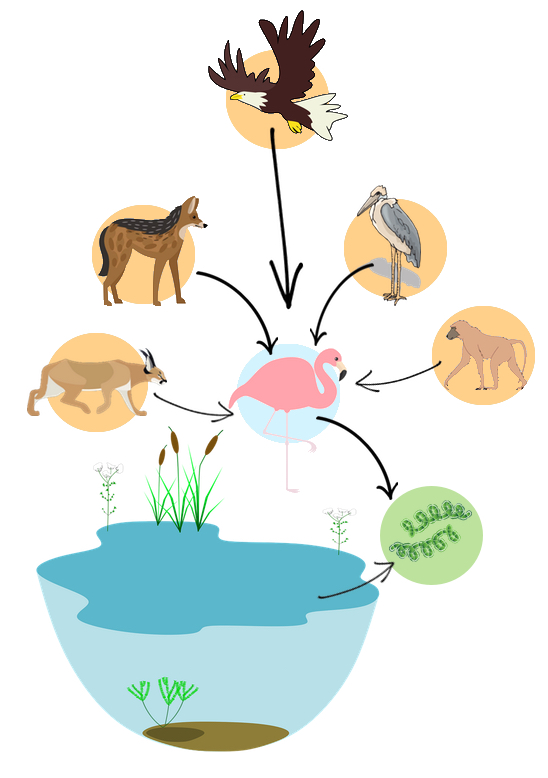Lesser Flamingo Species Information
 As its name suggests, the Lesser Flamingo is the smallest member of the flamingo family, the female being less than half the weight of the male Greater Flamingo. The Lesser Flamingo is pale to dark pink and has a characteristic deep-keeled dark red bill, with the lower half appearing black at a distance. The bill is adapted to take only small algae, also called cyanobacterias, which the flamingo filters carefully from the water surface. Each flamingo consumes about 60g of algae a day. Like any flamingo, the Lesser Flamingo lives in colonies that can count up to a million birds.
As its name suggests, the Lesser Flamingo is the smallest member of the flamingo family, the female being less than half the weight of the male Greater Flamingo. The Lesser Flamingo is pale to dark pink and has a characteristic deep-keeled dark red bill, with the lower half appearing black at a distance. The bill is adapted to take only small algae, also called cyanobacterias, which the flamingo filters carefully from the water surface. Each flamingo consumes about 60g of algae a day. Like any flamingo, the Lesser Flamingo lives in colonies that can count up to a million birds.
The pink color of the Lesser Flamingo comes from carotenoid pigments contained inside the cyanobacterias it consumes. Carotenoids are yellow to red pigments, usually found in plants and bacterias. Because the birds are not capable of synthetizing this pigment, they rely exclusively on their diet to maintain their color. As a result, birds kept in captivity without carotenoid supplements appear duller in color than wild flamingoes.
The Lesser Flamingo gathers in flocks on the alkaline lakes of the Great Rift Valley in East Africa. Outside the breeding season, huge feeding flocks congregate at sites such as Lake Bogona and Lake Naraku in Kenya. In South Africa, the Lesser Flamingo only breeds at Kamfer Dam in Kimberley.
Each flamingo pair lays a single egg every year, on top of a mud nest built on the shores of a large lake. The parents only regularly feed their young for a couple of weeks, the fledglings becoming capable of feeding themselves as soon as their beaks start growing the structures used for filtering the algae out of the water. The young flamingoes are quickly independent and remain in crèche for a few weeks, under the supervision of adults.
Flamingoes are prey to numerous predators, such as Baboons, Wildcats, Wolves, but also other birds like Marabou storks and Fish eagles. The human expansion has increased the threats weighing on these birds. Pollution and removal of breeding grounds for human activities have lessened the number of birds. As a result, the Lesser Flamingo is considered Near Threatened.
Quick facts
| Length | 80 - 90cm |
| Weight | 1,5 - 2kg |
| Wingspan | 90 - 105cm |
| Residence | Migratory bird |
| Habitat | Inland saline and alkaline lakes, usually with extensive mudflats and coastal lagoons |
Source: Wikipedia, BirdLife Bird Encyclopedia
Why are flamingoes important ?
Odd looking, pink birds, the flamingoes are often regarded as strange animals that are useful only when turned into lawn decorations. But is that really the case ? Are they only good as pink icons for making cute outfits and wall patterns ?
Maybe not :
The flamingoes play an important role in the food chain as preferred prey items for numerous predators. Eagles, hawks, jackals, caracals, wildcats, gulls and even hyenas use the brightly colored birds as feeding stocks during their own breeding season. It is so easy to simply pick up a young, flightless flamingo instead of running after older, more cunning prey items ! So much so that flamingoes have developed a technique to protect themselves against predators during the breeding season : strength in numbers. Being in a group, reproducing at the same time protects most of the younger birds from harm. Oh sure, there will be losses as predators come and take young away for their daily meals, but given the enormous number of chicks every year, it would be impossible for predators to kill all of them. And the more flamingoes in a group, the better this strategy works.
 Interestingly, most predators' breeding seasons are also correlated to the relative abundance of prey. In the case of flamingoes, their predators deliver their young when the flamingo chicks hatch. The large number of flamingo chicks helps the rearing of the young carnivores. Without easy food, no predators.
Interestingly, most predators' breeding seasons are also correlated to the relative abundance of prey. In the case of flamingoes, their predators deliver their young when the flamingo chicks hatch. The large number of flamingo chicks helps the rearing of the young carnivores. Without easy food, no predators.
And this statement is even more important when talking about rescue and rehabilitation of injured wild animals.
Contrary to common beliefs, the wild is not a perfect world. Prey are eaten by predators, and the misfortune of the one benefits the other. An injured bird might seem in need of help, but by removing it from the wild we are actually depriving another animal from its dinner, thus putting the predators' species at risk. It is important to help and preserve endangered species, which numbers have been wiped out by natural catastrophes or human related/caused problems. However, in the case of common species such as the flamingo, we have to remember that by removing an injured animal from the food chain, we are actually lessening the chances of survival for numerous other species, including predators, scavengers and decomposers.
It all comes down to balance. If a species is thriving, there is a good chance that its predators' population are in good health too. By maintaining high numbers of flamingoes alive, we are actually helping many other species to survive.
As humans, we don't really have a culinary interest in flamingoes. It is true that flamingoes have been used during middle ages as a delicacy, presented on the lords' tables in all their glory, pink feathers carefully replaced on the skin after cooking. But nowadays, these large birds are quite far from our kitchen, and with good reason. Out of the six flamingo species in the world three are classified as near threatened and one is vulnerable on the IUCN red list. By the look of it, it will not be long before all the flamingo species find themselves on the endangered list due to threatening human activities.
In recent years, flamingoes have been chased away from their breeding grounds, poisoned by pollution, and even hunted for food. As for many species, flamingoes are now becoming part of what is called "Bushmeat", in other words, a species hunted for its meat by nearby populations with poor access to farm raised animals.
However, although the situation seems badly engaged, there is still hope for one human activity to come to the help of these pink birds : tourism. Millions of visitors travel thousands of miles to admire the large flamingo flocks in their natural environments. The revenues generated by the tourism industry are high enough to influence governing bodies in their decisions.
Recently, a soda ash mining company was declined the right to extract soda ash from Lake Natron in Tanzania. The reason stated by authorities was that it would certainly disturb the flamingoes using the lake as a breeding site, maybe even force them to leave, and thus substantially reduce the income from the tourism industry.